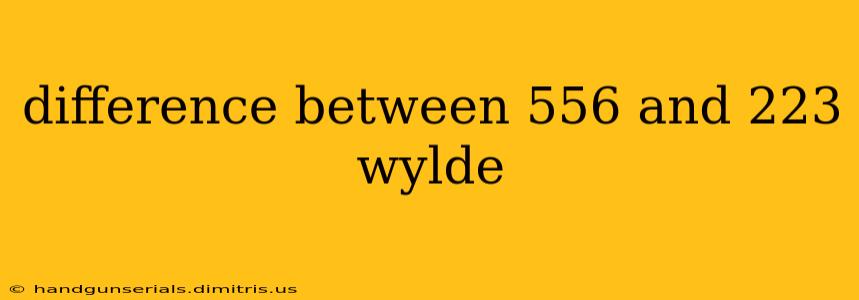Choosing the right cartridge for your AR-15 platform can feel overwhelming, especially when faced with similar options like 5.56 NATO and .223 Wylde. While seemingly minor, the distinctions between these two popular calibers significantly impact performance, accuracy, and overall firearm functionality. This detailed comparison will illuminate the key differences, helping you make an informed decision.
Understanding the Chamber Specifications
The core difference lies in the chamber specifications. These specifications dictate the cartridge's physical dimensions and how it interacts with the firearm's barrel and bolt. This seemingly small variation significantly impacts the performance and reliability of your AR-15.
-
5.56 NATO: This military-grade cartridge is designed to withstand the higher pressures generated during firing. Its chamber is slightly larger, allowing for a wider range of ammunition, including both 5.56 NATO and (generally) .223 Remington. However, this larger chamber can lead to less consistent accuracy with .223 Remington ammunition.
-
.223 Wylde: This chamber is a hybrid, aiming to bridge the gap between the 5.56 NATO and .223 Remington specifications. It's designed to handle both cartridge types safely and accurately. The .223 Wylde chamber is more precisely dimensioned than the 5.56 NATO chamber, promoting better accuracy and consistency with both types of ammunition.
Performance and Accuracy: A Comparative Analysis
The differences in chamber dimensions directly translate to differences in performance and accuracy:
Accuracy:
-
.223 Wylde: Generally offers superior accuracy, particularly with .223 Remington ammunition. The tighter chamber ensures more consistent bullet seating and a more precise launch. This translates to tighter groups at the target.
-
5.56 NATO: Can achieve acceptable accuracy, especially with 5.56 NATO ammunition. However, the larger chamber can lead to less consistent performance when using .223 Remington ammunition, potentially resulting in wider shot groups and reduced accuracy.
Reliability:
-
5.56 NATO: Its larger chamber makes it more reliable with a wider range of ammunition, including military-spec 5.56 NATO rounds which are typically loaded to higher pressure than their commercial counterparts. This means less chance of malfunctions.
-
.223 Wylde: While extremely reliable with both 5.56 NATO and .223 Remington, the tighter tolerances may make it slightly more sensitive to ammunition variations. Using correctly sized ammunition is crucial for optimal performance.
Pressure Considerations: A Critical Safety Aspect
The pressure generated during firing is a crucial safety factor. While both chambers are designed to be safe, understanding the differences is vital.
-
5.56 NATO: Designed to handle the higher pressures of 5.56 NATO ammunition. Firing .223 Remington in a 5.56 NATO chamber generally is considered safe, but the higher chamber volume may reduce accuracy.
-
.223 Wylde: Designed for optimal accuracy and performance with both .223 Remington and 5.56 NATO, but with a slight preference for the former. Using the correctly specified ammunition is essential to prevent potential problems.
Which Chamber is Right for You?
The choice between 5.56 NATO and .223 Wylde depends on your priorities and intended use.
-
Choose 5.56 NATO if: You prioritize compatibility with a wider range of ammunition, including military-spec 5.56 NATO rounds, and need the utmost reliability in varied conditions, even with some reduction in accuracy when using .223 Remington.
-
Choose .223 Wylde if: Accuracy and precise performance are your primary concerns. You're willing to prioritize using suitable ammunition for optimal results and potentially sacrificing a small amount of versatility.
Conclusion: Informed Decisions for Optimal Performance
Understanding the nuanced differences between 5.56 NATO and .223 Wylde chambers is vital for choosing the right AR-15 platform for your needs. Both chambers offer reliable performance, but their unique characteristics influence accuracy, reliability, and compatibility with different ammunition types. By carefully considering these factors, you can make an informed decision that aligns with your shooting style, experience level, and intended use. Remember always to consult your firearm's manual and follow safe firearm handling practices.

